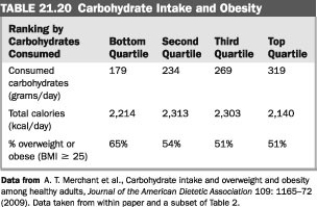Multiple Choice
The data in the accompanying table came from a study where adults reported their dietary intake and researchers measured their BMIs to measure obesity rates. The results seem to suggest that low-carbohydrate diets are associated with lower body weights. However, this is a case of correlation and not causation. Therefore, what else could possibly explain these results? 
A) The people who ate the most carbohydrates exercised more than the other groups.
B) The people who ate the least carbohydrates exercised more than the other groups.
C) The people who ate the most carbohydrates took more vitamins than the other groups.
D) The people who ate the least carbohydrates took more vitamins than the other groups.
Correct Answer:

Verified
Correct Answer:
Verified
Q4: Digestion is the<br>A) absorption of nutrients suspended
Q5: Which of the following statements regarding metabolism
Q6: The parietal cells of the stomach are
Q7: The mucus-producing cells that line the stomach<br>A)
Q8: The rate of energy consumption by an
Q10: <img src="https://d2lvgg3v3hfg70.cloudfront.net/TB6039/.jpg" alt=" -According
Q11: Which of these teeth is an incisor?
Q12: Which arrow shows the release of digestive
Q13: The structure of the esophagus fits its
Q14: Which of the following organisms has a